
Written by: Michael Nadeau, The DeFi Report; Compiled by: Glendon, Techub News
Launched in 2018, Uniswap is a breakthrough innovation that enables the organic formation of a two-sided market for financial asset transactions.Since its inception, the protocol has generated more than $3.3 trillion in transaction volume and $4.7 billion in transaction fees.
However, we have always regarded Uniswap as a project not worth investing in.
Why is this?
Uniswap has multiple capital tables, one for equity investors and one for token holders.This structure is not unique to Uniswap, but what is unique is that Uniswap often distributes revenue to equity holders rather than token holders.
This is a serious conflict of interest.
But interestingly, that all seems to be about to change under the recent governance proposal put forward by Uniswap founder Hayden Adams.Today, we’ll break down the implications of this governance proposal from a token holder’s perspective and provide the latest data and information on Uniswap fundamentals.
Uniswap organizational structure
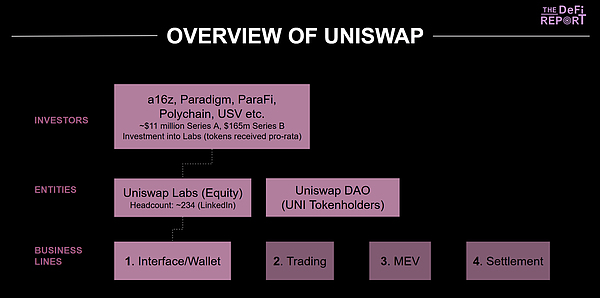
Equity Holders and Token Holders (DAO)
In traditional finance, it’s not uncommon for companies to issue multiple classes of stock.For example, in the event of a company liquidation, preferred stockholders typically have a higher claim on assets than common stockholders.That is, investors generally believe that if a company performs well (increases revenue and profits), the value it creates will be distributed proportionally among all classes of shares.
Therefore, ownership of Uniswap (or any crypto project or company) must be vested in a single investment vehicle.In this case, the investment vehicle is the UNI token.
Why do you say that?
Because if Uniswap Labs (core team + investors) extract revenue from various business lines without regard to UNI token holders (who have no legal rights), the market may lose trust in the governance of Uniswap DAO.
This is exactly what happened.
Here’s why we don’t think UNI is worth investing in.
Now, let’s break down the individual lines of business and how they might change under the new proposal structure.
Uniswap business line and value attribution
In this section, we will explain the current revenue streams within the Uniswap organizational structure and how subsequent revenue will be distributed if the governance proposal is passed (it currently has 100% support).
Interface/Wallet
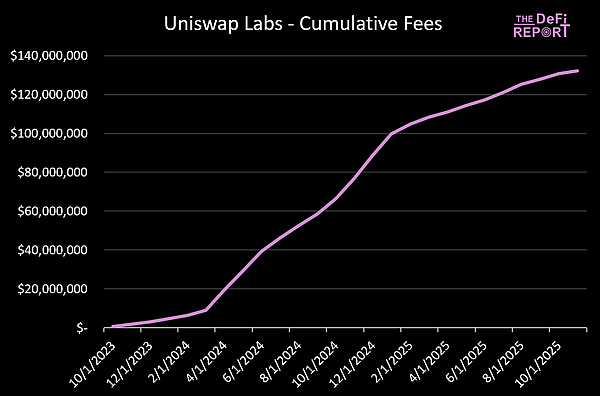
In 2023, Uniswap Labs unilaterally charged a fee of 0.15% (later increased to 0.25%) for users who interact with Uniswap through the official Uniswap website interface or the Uniswap wallet (mobile users).
Uniswap Labs has amassed $132 million to date.
However, UNI token holders have no say in this decision and have no right to claim these fees.This clearly must change.
Key takeaways for token holders
Under the structure of the new proposal, Uniswap will shut down its interface, wallet and API fees.
Labs will also serve the interests of UNI token holders through a contractual commitment to only pursue initiatives that are in the interest of DUNI, a new legal entity of the Foundation formed under the model of a decentralized unincorporated non-profit organization registered in Wyoming.
While aligning Labs with DUNI/token holders, this will eliminate $132 million in fees incurred since the beginning of 2023.If any of these costs were used to fund protocol development, these costs will have to be borne from other sources going forward.
Transaction/Smart Contract
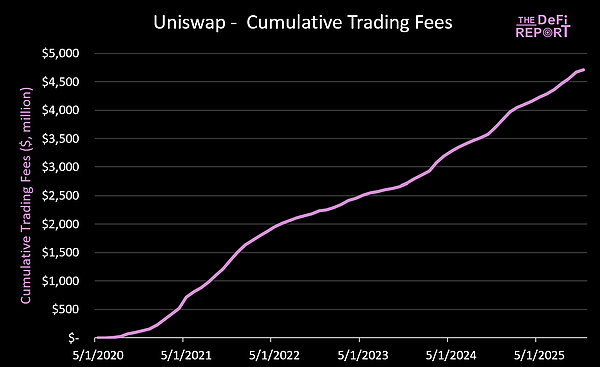
Uniswap’s main source of revenue is its trading business.Since its inception, the protocol has generated over $4.7 billion in transaction fee revenue.
100% of these fees are paid to third-party liquidity providers (LPs).However, the governance proposal will turn on the “fee switch” for token holders as follows:
The protocol fee for the V2 pool is 0.05%;
The protocol fees for the 0.01% and 0.05% v3 trading pools are initially set to 1/4 of the LP fees;
The protocol fees for the 0.30% and 1% v3 trading pools are set at 1/6 of the LP fees.
If approved, the fee switch will be rolled out gradually, first applying to the V2 and V3 pools on the Ethereum mainnet that account for 80-95% of liquidity provider fees.All fees generated by the new fee switch will be used to programmatically destroy UNI tokens (thus accumulating value for token holders).
LP transaction fees and agreement fees
The chart below illustrates the fee allocation scheme that applies from the outset between the LP and the protocol.Protocol fees (blue) will be burned, reducing the circulating supply of UNI.
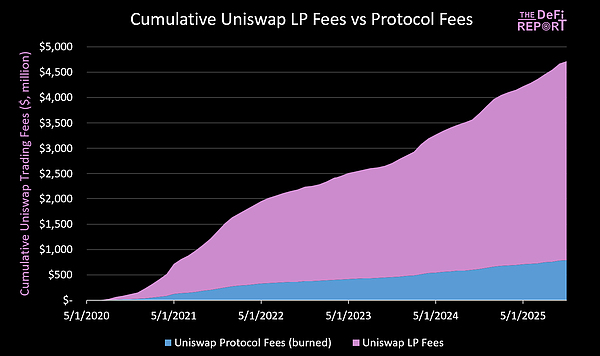
Main points
Looking back, we estimate that approximately $780 million worth of UNI tokens will be burned.If the governance proposal passes, Uniswap will retroactively destroy 100 million UNI tokens (worth $663 million at current UNI prices).
This will reduce existing token circulation by approximately 16%.
Impact on liquidity providers
While protocol fees would shift some transaction fees away from liquidity providers, the governance proposal includes a fee mechanism designed to improve LP performance and introduce new fee sources by internalizing MEV.
That is, MEV captured by the protocol (which would have been distributed to validators) will be destroyed after the upgrade (owned by token holders, not LPs).
Unichain
Unichain is a general-purpose Ethereum L2 launched by Uniswap 9 months ago.
It currently handles $100 billion in annualized decentralized exchange (DEX) trading volume and has generated more than $3 million in cumulative sequencer fees.
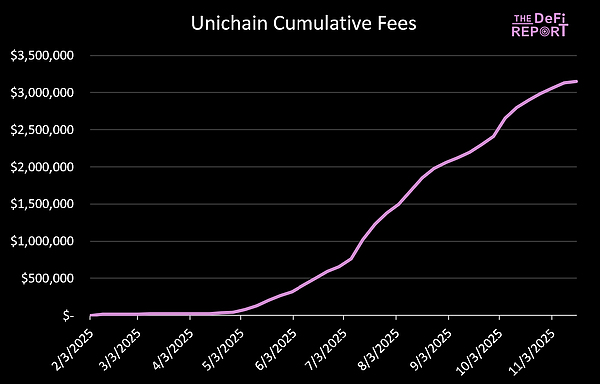
Main points
If the governance proposal is passed, these fees (less L1 data costs and the 15% fee paid to the OP) will also be converted to burned UNI.
Uniswap fundamentals update
This part will conduct a “health check” on Uniswap key performance indicators (KPIs).
trading volume
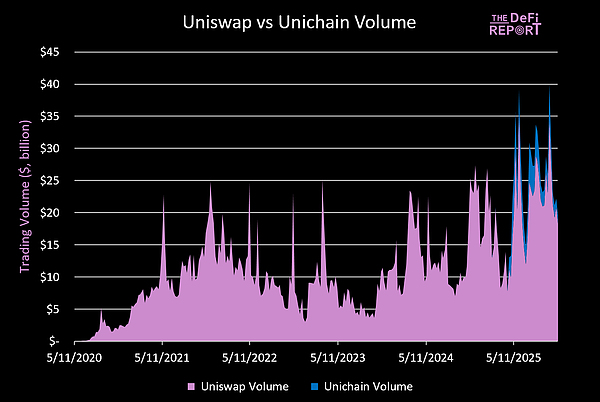
Although much of the speculation this cycle has shifted to Solana and Hyperliquid, Uniswap’s trading volume has continued to grow.The protocol’s trading volume peaked at $34 billion in the week of October 6, a 50% increase over its best weekly volume of the 2021 cycle.
Transaction volume by chain
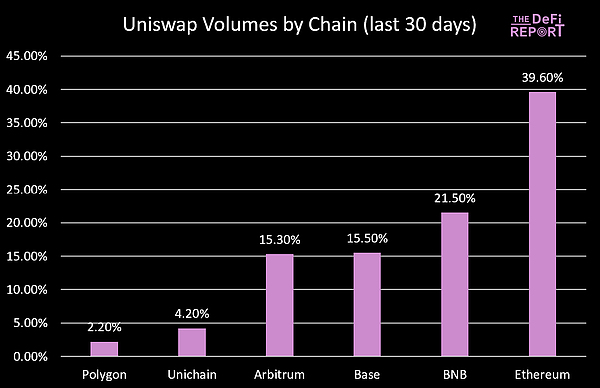
40% of Uniswap’s trading volume currently comes from Ethereum, down from 55% last year.
For reference, the BNB chain’s share increased from 2% a year ago, and the Base chain’s share also increased from 15.3% a year ago.Finally, Unichain currently accounts for 4.2% of Uniswap’s total trading volume.
Transaction volume by version
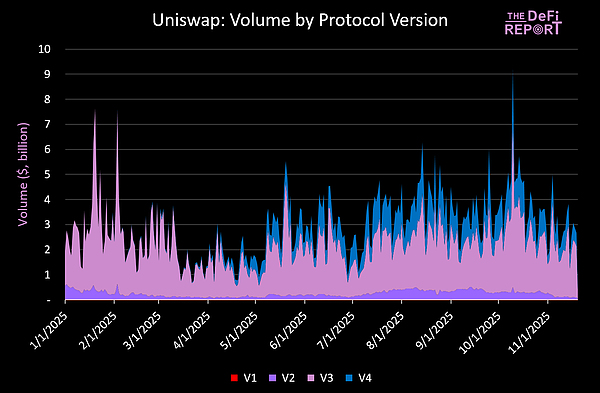
V3 (pink) was launched in May 2021, and 68.7% of Uniswap’s trading volume currently runs through V3; V4 (blue) was launched in January this year, and currently accounts for 24.9% of the trading volume; as for V2, which was launched in May 2020, it still accounts for 6.3% of the trading volume at this stage.
“Organic Transaction Volume” and “Inorganic Transaction Volume”
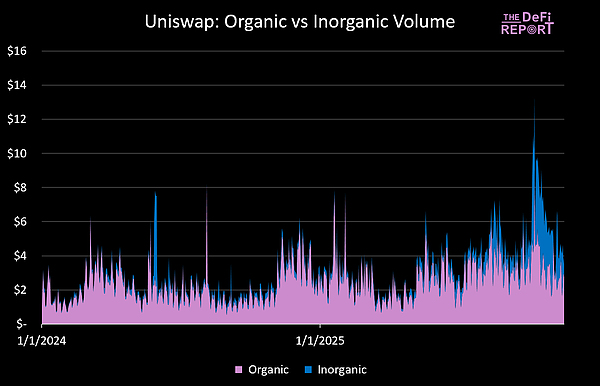
Uniswap’s trading volume looks very healthy.But we must be clear that these data actually include “wash transaction volume.”Therefore, we wanted to better understand Uniswap’s true trading volume, i.e. the difference between “organic trading volume” and its “inorganic trading volume”.
This article derives “inorganic trading volume” by aggregating trading volumes from trading pools that meet the following criteria:
The trading pool has less than 1000 unique addresses
Trading days are less than 10 days
A single trader accounts for more than 30%
Traffic in the top 10 addresses or fewer, but accounting for more than 80% of the total traffic.
Median transaction volume is less than $25,000.
By applying these filters, we find that 12.3% of Uniswap volume in 2024 is “inorganic volume.”In 2025, this proportion almost doubled to 23.3%.What is even more noteworthy is that after the liquidation event on October 10, “inorganic transaction volume” surged significantly, accounting for once soaring to 43%.
Why is this?We believe this may be because market sentiment is low and some pools with lower trading volumes are “faking” trading volumes to attract new traders.
New users and old users
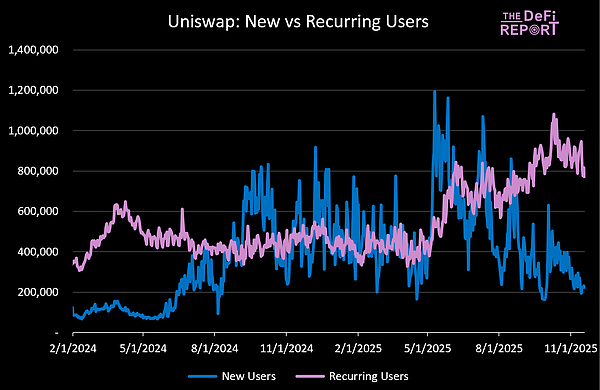
Uniswap’s average daily active users have exceeded 857,000 over the past 30 days, up from 450,000 per day a year ago.
However, in terms of new users/transaction addresses, the protocol is currently averaging 278,000 new users/transaction addresses per day, down from 434,000 users/transaction addresses per day a year ago.
final thoughts
If the recent governance proposals are passed as expected, we will re-evaluate Uniswap.Specifically, it will no longer be a protocol that is not worth investing in.
In addition, this move may force other protocols to take similar measures to coordinate the interests of token holders – which is a healthy development trend for the industry.
Core implications of governance proposals
Impact on Uniswap Labs
Uniswap Labs will lose interface, wallet, and API fee revenue as their focus will shift to exclusively serving DAO/token holders.If the $132 million previously received from these revenue sources was used to fund protocol development, then this portion of future funding will need to be obtained from other sources.Uniswap users will undoubtedly be the biggest winners of this proposal.
Impact on Liquidity Providers (LPs)
Liquidity providers will lose about 16% of the trading fees due to the protocol fee switch, but will benefit from the optimization of the protocol fee discount auction (PFDA).Uniswap estimates that the new auction mechanism can enable LPs to earn an additional $0.06-0.26 per $10,000 in transaction volume.
Impact on token holders/token economics
100 million UNI (worth $663 million at current UNI prices) will be destroyed.The circulating supply of UNI will drop from 629 million to 529 million, and the token price will rise to $7.88 due to the reduction in circulation.
Going forward, approximately 16% of transaction fee revenue will be destroyed.This would be equivalent to the destruction of $136 million worth of UNI tokens so far this year (20.5 million UNI).Additionally, $3 million worth of Unichain orderer fees will be burned (452,000 UNI).
These changes will have a positive impact on UNI holders.
Impact on traders
There should be no material impact to traders, other than more efficient trade execution through the new PFDA auction mechanism.Transaction fees will remain unchanged.
Uniswap current valuation comparison

Summary of key points
The proposed changes aligned with UNI holders have had no impact on the relative valuation of Uniswap compared to Aerodrome (Base), Raydium (Solana) or Pump (Solana).
However, it now puts UNI holders on an equal playing field in terms of token economics and value accretion for token holders.As shown above, Raydium appears to be significantly undervalued relative to its peers.
future outlook
How will the winner of the DEX category be determined?
Ultimately, we think it’s up to Wall Street to decide where to build.We should start getting some answers in the next year or two.
Ultimately, we think it’s up to Wall Street to decide where to “build.”Within the next year or two, we should have some answers.
One thing we’re paying close attention to is Uniswap’s “hooks,” which were launched in v4 earlier this year.”Hooks” can achieve the following functions:
Dynamic fees (fees that automatically adjust based on volatility);
On-chain KYC/permission pool (required for institutional users);
Time-weighted average market maker execution (allowing slow execution of large orders);
Oracle enhanced pool (transaction pricing can refer to external oracles);
Custom fee flow (automatically destroy tokens or distribute them to stakers);
Circuit breakers/risk rules (suspension of trading in times of extreme volatility);
Centralized liquidity automation (automatic rebalancing of liquidity provider positions).
We believe this (already built) infrastructure is what agencies will consider when deciding where to locate.Uniswap was once “forgotten” in this trading cycle, but now that the foundation has been laid, it may reverse its decline in the next trading cycle.







